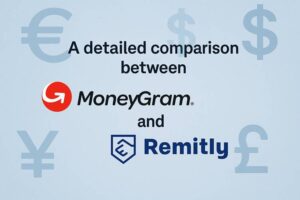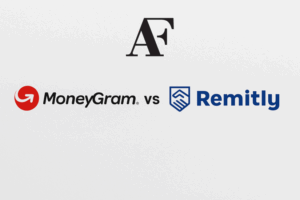MoneyGram operates as a traditional money transfer giant with extensive physical locations worldwide. Remitly functions as a modern digital-first platform designed specifically for online transfers.
When choosing between international money transfer services, MoneyGram and Remitly represent two distinct approaches to cross-border payments.
In this article, we are going to discuss:
- What is the purpose of Remitly?
- What is the purpose of MoneyGram?
- What is the safest transfer method, MoneyGram or Remitly?
- What is the cheapest money transfer method, MoneyGram or Remitly?
- What is the best way to transfer money, MoneyGram or Remitly?
If you are looking to invest as an expat or high-net-worth individual, you can email me (hello@adamfayed.com) or WhatsApp (+44-7393-450-837).
This includes if you are looking for a free expat portfolio review service to optimize your investments and identify growth prospects.
Some facts might change from the time of writing. Nothing written here is financial, legal, tax, or any kind of individual advice, nor is it a solicitation to invest or a recommendation of any specific product or service.

What services are offered by Remitly?
Remitly operates as a Seattle-based online international money transfer company founded in 2011 by Matt Oppenheimer.
The platform enables users to send money from 16 developed countries, including the United States, the United Kingdom, Ireland, Australia, Canada, and several European nations to over 50 countries worldwide.
This digital-first approach distinguishes Remitly from traditional money transfer services by prioritizing online convenience and mobile accessibility.
By the fourth quarter of 2023, Remitly served 5.9 million active customers and processed $11.1 billion in send volume, representing a 41% increase in customers and 38% growth in volume compared to the previous year.
This expansion reflects the growing demand for digital money transfer solutions among international migrants and global workers.
Payment methods on Remitly include bank account transfers, debit card payments, and credit card transactions.
Recipients can receive funds through various delivery options, like direct bank account deposits, mobile wallet transfers, and cash pickup at approximately 140,000 agent locations globally.
However, delivery options vary by destination country, with some locations like India only supporting bank account deposits.
The platform implements transfer limits based on customer verification levels and regulatory requirements.
For transfers exceeding $2,999 within 24 hours, customers must provide additional documentation such as Social Security Numbers or Individual Taxpayer Identification Numbers.
These limits help ensure compliance with anti-money laundering regulations while protecting customers from potential fraud.
Remitly generates revenue through competitive exchange rates and transparent fees rather than hidden charges.
The platform displays total costs and delivery timeframes before customers complete transactions, enabling informed decision-making.
Exchange rates are updated regularly to reflect current market conditions, though rates can fluctuate between the time customers check and when they complete transfers.
What services does MoneyGram offer?
MoneyGram operates as one of the world’s largest money transfer networks.
It provides services across more than 200 countries and territories through approximately 350,000 agent locations worldwide.
This extensive physical network enables customers to send and receive money through traditional in-person transactions at retail locations, banks, and financial service providers.
In India, MoneyGram operates as a receive-only service, meaning customers can collect transferred funds but cannot initiate new transfers from Indian locations.
This arrangement reflects regulatory requirements and market positioning within specific countries.
MoneyGram has evolved beyond traditional money transfers to offer comprehensive financial services through the MoneyGram Account platform.
This digital banking solution provides customers with FDIC-insured accounts backed by Pathward, National Association, ensuring deposit protection.
The FDIC insurance coverage protects customer funds against institutional failure, providing additional security compared to non-insured digital wallets.
The MoneyGram Account includes a Visa digital debit card that customers can use for purchases anywhere Visa is accepted.
Physical debit cards are available upon request, and the digital version integrates with Apple Pay and Google Pay for mobile payment convenience.
Customers can freeze and unfreeze their debit cards directly through the MoneyGram mobile application, providing immediate control over account security.
Fund management capabilities through the MoneyGram Account enable seamless transfers between MoneyGram accounts and external bank accounts.
Transfers between MoneyGram Account holders incur no fees, creating cost advantages for frequent users within the network.
However, the service does not support traditional check processing or provide physical check books, focusing instead on digital payment methods and debit card transactions.
MoneyGram’s fee structure varies based on transfer amounts, destination countries, and delivery methods.
Agent location transfers typically involve higher fees compared to digital bank transfers, reflecting the operational costs of maintaining physical infrastructure.
The company competes with digital-first platforms by offering reliability and accessibility in markets where internet connectivity or digital literacy may present challenges.
MoneyGram vs Remitly: Detailed Comparison

What is the most reliable way to send money, MoneyGram or Remitly?
Reliability in money transfers encompasses several critical factors including delivery success rates, customer service accessibility, regulatory compliance, and financial stability.
Remitly addresses reliability concerns through its delivery guarantee program, promising to refund fees if transfers fail to arrive on time.
This guarantee provides customers with recourse when delays occur due to technical issues or processing complications.
MoneyGram’s reliability stems from its established global infrastructure and regulatory compliance across 200+ countries and territories.
The company’s extensive agent network provides alternative delivery channels when digital systems experience disruptions.
Physical locations offer face-to-face customer service and manual transaction processing capabilities that can resolve complex transfer issues requiring human intervention.
Both services implement multiple security layers to protect customer data and prevent fraudulent transactions.
Remitly encrypts all transfers and employs fraud protection systems designed to identify suspicious activity patterns.
Meanwhile, MoneyGram’s established compliance framework includes anti-money laundering protocols and customer verification procedures developed over decades of international operation.
Financial stability considerations favor MoneyGram’s longer operational history and established market position compared to Remitly’s newer digital-focused approach.
However, Remitly’s recent growth trajectory and substantial funding rounds demonstrate strong investor confidence in the company’s business model.
Customer support accessibility differs between the platforms, with MoneyGram offering in-person assistance at agent locations while Remitly primarily provides digital support channels.
This distinction becomes important when customers encounter complex issues requiring detailed explanation or documentation review.
Which is cheaper to send money, MoneyGram or Remitly?
Remitly emphasizes transparent pricing by displaying total costs and delivery time frames before customers complete transactions.
This upfront disclosure helps customers understand exactly what they will pay without encountering surprise charges during the transfer process.
MoneyGram’s fee structure varies significantly based on delivery methods, with cash pickup services typically carrying higher fees than direct bank transfers.
The company’s extensive agent network requires operational funding that is reflected in transfer costs, particularly for in-person transactions.
Digital transfers through MoneyGram’s online platform generally offer more competitive pricing compared to agent location services.
Payment method selection impacts costs for both services, with credit card payments typically attracting higher fees than bank account or debit card transfers.
Remitly clearly communicates these differences, allowing customers to choose payment options based on their cost preferences and urgency requirements.
The platform’s fee structure aims to compete with traditional providers by offering lower costs for digital transactions.
Transfer limits also influence cost-effectiveness, as both services may impose higher fees or require additional verification for large transfers.
Remitly’s tiered verification system allows customers to increase transfer limits by providing additional documentation, though this may involve processing delays.
MoneyGram’s established compliance infrastructure can handle larger transfers more efficiently in many markets.
Hidden costs often emerge through unfavorable exchange rates rather than explicit fees.
Both services generate revenue through exchange rate margins, marking up the mid-market rate to create profit margins.
Customers should compare the actual exchange rates offered by each service against current market rates to understand true transfer costs.
Which money transfer gives the best rates, MoneyGram or Remitly?
Remitly positions itself as offering competitive exchange rates with transparent pricing that displays real-time conversions before customers commit to transfers.
The platform updates rates regularly to reflect market movements, though customers should complete transactions promptly to secure the displayed rates.
MoneyGram’s exchange rates vary across different service channels, with digital transfers typically offering better rates than cash pickup services.
The company’s rate structure reflects the operational costs associated with maintaining physical infrastructure and agent commissions.
Customers seeking the most favorable rates should compare online versus in-person transfer options within MoneyGram’s service ecosystem.
Market volatility affects both services’ ability to offer consistent exchange rates over time.
Currency fluctuations can create significant differences between quoted rates and final conversion amounts, particularly for transfers requiring several days for completion.
Remitly’s faster digital processing may provide advantages during periods of high market volatility by reducing exposure to rate changes.
Both platforms compete with specialized foreign exchange providers who may offer better rates for large transfers.
Rate comparison tools and services allow customers to evaluate multiple providers simultaneously, ensuring they receive optimal conversion rates for their specific transfer requirements.
Regular users should monitor rate patterns to identify optimal timing for recurring transfers.
The actual rate of competitiveness depends heavily on specific currency pairs and transfer corridors.
Some routes may favor Remitly’s digital efficiency, while others might benefit from MoneyGram’s established banking relationships and local market presence.
What is the best way to transfer money overseas, MoneyGram or Remitly?
Remitly excels for digital-savvy users who prioritize online convenience and mobile applications for transfer management.
The platform’s streamlined interface enables quick transfers from any location with internet connectivity, making it ideal for busy professionals and frequent senders.
MoneyGram provides superior options for recipients in underbanked regions where digital infrastructure may be limited or unreliable.
The extensive agent network ensures recipients can access funds even in remote locations without bank accounts or internet access.
This accessibility advantage becomes crucial when sending money to rural areas or countries with developing financial systems.
Transfer urgency influences the optimal choice, as both services offer different speed options with corresponding cost implications.
Remitly’s digital processing can deliver funds within minutes for bank account transfers in supported corridors.
MoneyGram’s cash pickup services provide immediate availability once transfers are processed, though processing times may vary based on verification requirements.
Recipient preferences significantly impact the best transfer method selection.
Some beneficiaries prefer bank account deposits for security and record-keeping purposes, while others require cash pickup due to limited banking access.
Understanding recipient needs and local infrastructure capabilities helps determine which service provides optimal delivery options.
Regulatory considerations also affect overseas transfer choices, as different countries impose varying restrictions on money transfer services.
Both MoneyGram and Remitly maintain compliance with international regulations, but specific corridors may favor one provider’s licensing arrangements over the other.
Customers should verify service availability and any restrictions in destination countries before selecting transfer methods.
Key Takeaways
The choice between MoneyGram and Remitly ultimately depends on individual transfer needs, recipient circumstances, and personal preferences regarding digital versus traditional financial services.
- Digital Preference: Choose Remitly for mobile-first convenience, transparent pricing, and faster digital processing capabilities.
- Physical Access: Select MoneyGram when recipients need cash pickup services or live in areas with limited digital infrastructure.
- Cost Comparison: Always compare exchange rates and total fees between both services for specific transfer corridors before making decisions.
- Transfer Speed: Consider urgency requirements, as both services offer different delivery timeframes with corresponding cost implications.
- Recipient Needs: Evaluate whether beneficiaries prefer bank deposits, mobile wallets, or cash pickup based on their local banking access and preferences.
- Transfer Frequency: Regular users should assess loyalty programs, fee structures, and rate consistency over time rather than single-transaction costs.
- Verification Requirements: Understand documentation needs for different transfer amounts, as both services implement tiered verification systems for compliance purposes.
Pained by financial indecision?

Adam is an internationally recognised author on financial matters with over 830million answer views on Quora, a widely sold book on Amazon, and a contributor on Forbes.


